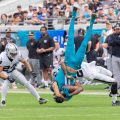[Update, May 23, 2018: As I predicted almost a year ago, before the lawsuit was even filed, Trump’s twitter feed is indeed a public forum. A federal district court just denied his motion to dismiss. I haven’t read it in full yet, but I’ll update this post when I’ve had a chance.]
[Update, June 6, 2017: A week after I wrote the below, the Knight Institute wrote a letter to President Trump arguing the same. Eugene Volokh says there’s a “private capacity” argument. I addressed that below, the same way the Davison court ruled on it. Moreover, just today Press Secretary Sean Spicer admitted the tweets are “official statements by the President of the United States.” Also, Charles Ornstein has a good summary of other elected officials blocking constituents, and litigation over it.]
While in the White House, Donald Trump’s personal twitter timeline, @realDonaldTrump, remains a key method by which he communicates with the public. He uses it to conduct foreign policy, to urge specific action by Congress, to promote certain media articles, and, of course, to persuade the public on key issues, including with implied references to classified government information. And, critically for our purposes here, he allows the public, the media, and other elected representatives to post tens of thousands of comments in response to each tweet:
As Danny Sullivan pointed out, President Trump has recently become more aggressive in blocking people on Twitter, and so Sullivan has created a list of blocked users. Sullivan wonders if this creates a First Amendment issue, noting,
When Trump blocks, he doesn’t just impact himself. He blocks some Americans from speaking in arguably the most important forum, his tweets.
For our purposes here, I’ll refer to @realDonaldTrump’s tweets as “tweets,” and the responses to them as “replies,” so we don’t get confused. When @realDonaldTrump “blocks” someone on Twitter, they can no longer read his tweets or reply to them. That is in contrast to “muting,” which removes the person’s replies from @realDonaldTrump’s view but leaves them up for other users.
So, are President Trump’s tweets a public forum? If so, does that place limits on when President Trump can block users from replying?
I believe the answers are “yes” and “yes.” Because President Trump uses @realDonaldTrump for official business, and because President Trump allows (arguably, invites) replies on his tweets, he has made his Twitter timeline into a limited public forum. As such, the First Amendment applies. He can potentially impose content restrictions, but he can’t impose viewpoint restrictions.
Here’s why.
For years, legal scholars have wondered about how the First Amendment applies to government-sponsored social media accounts. For example, see this 2011 article on “Government Sponsored Social Media and Public Forum Doctrine Under the First Amendment: Perils and Pitfalls.”
The basic concepts of a “limited public forum” are well-settled in the Supreme Court:
It is axiomatic that the government may not regulate speech based on its substantive content or the message it conveys. Other principles follow from this precept. In the realm of private speech or expression, government regulation may not favor one speaker over another. Discrimination against speech because of its message is presumed to be unconstitutional. These rules informed our determination that the government offends the First Amendment when it imposes financial burdens on certain speakers based on the content of their expression. When the government targets not subject matter, but particular views taken by speakers on a subject, the violation of the First Amendment is all the more blatant. Viewpoint discrimination is thus an egregious form of content discrimination. The government must abstain from regulating speech when the specific motivating ideology or the opinion or perspective of the speaker is the rationale for the restriction.
These principles provide the framework forbidding the State to exercise viewpoint discrimination, even when the limited public forum is one of its own creation. In a case involving a school district’s provision of school facilities for private uses, we declared that there is no question that the District, like the private owner of property, may legally preserve the property under its control for the use to which it is dedicated. The necessities of confining a forum to the limited and legitimate purposes for which it was created may justify the State in reserving it for certain groups or for the discussion of certain topics. Once it has opened a limited forum, however, the State must respect the lawful boundaries it has itself set. The State may not exclude speech where its distinction is not reasonable in light of the purpose served by the forum, nor may it discriminate against speech on the basis of its viewpoint. Thus, in determining whether the State is acting to preserve the limits of the forum it has created so that the exclusion of a class of speech is legitimate, we have observed a distinction between, on the one hand, content discrimination, which may be permissible if it preserves the purposes of that limited forum, and, on the other hand, viewpoint discrimination, which is presumed impermissible when directed against speech otherwise within the forum’s limitations.
Rosenberger v. Rector & Visitors of Univ. of Virginia, 515 U.S. 819, 828–30, 115 S. Ct. 2510, 2516–17, 132 L. Ed. 2d 700 (1995)(emphasis added, citations and quotations omitted). Rosenberger involved the use of student activities funds at state universities. As the Supreme Court recognized, “The [fund] is a forum more in a metaphysical than in a spatial or geographic sense, but the same principles are applicable.” Id. at 830.
So, what about the “metaphysical” forum of social media?
For starters, the Supreme Court has been quite clear that online speech is worthy of the same level of protection as other speech. See Reno v. ACLU, 521 U.S. 844, 870, 117 S.Ct. 2329, 138 L.Ed.2d 874 (1997); see also Ashcroft v. ACLU, 542 U.S. 656, 124 S.Ct. 2783, 159 L.Ed.2d 690 (2004). The federal appellate courts, too, have recognized that the use of social media can constitute expressive speech. Below is a passage from the Fourth Circuit; it might seem tiresome to read a lengthy discussion of the “like” button on Facebook, but that detailed analysis is critical to understanding how even minimal use of social media can be the exercise of free speech.
Here, Carter visited the Jim Adams’s campaign Facebook page (the “Campaign Page”), which was named “Jim Adams for Hampton Sheriff,” and he clicked the “like” button on the Campaign Page. When he did so, the Campaign Page’s name and a photo of Adams—which an Adams campaign representative had selected as the Page’s icon—were added to Carter’s profile, which all Facebook users could view. On Carter’s profile, the Campaign Page name served as a link to the Campaign Page. Carter’s clicking on the “like” button also caused an announcement that Carter liked the Campaign Page to appear in the news feeds of Carter’s friends. And it caused Carter’s name and his profile photo to be added to the Campaign Page’s “People [Who] Like This” list.
Once one understands the nature of what Carter did by liking the Campaign Page, it becomes apparent that his conduct qualifies as speech. On the most basic level, clicking on the “like” button literally causes to be published the statement that the User “likes” something, which is itself a substantive statement. In the context of a political campaign’s Facebook page, the meaning that the user approves of the candidacy whose page is being liked is unmistakable. That a user may use a single mouse click to produce that message that he likes the page instead of typing the same message with several individual key strokes is of no constitutional significance.
Aside from the fact that liking the Campaign Page constituted pure speech, it also was symbolic expression. The distribution of the universally understood “thumbs up” symbol in association with Adams’s campaign page, like the actual text that liking the page produced, conveyed that Carter supported Adams’s candidacy. See Spence v. Washington, 418 U.S. 405, 410–11, 94 S.Ct. 2727, 41 L.Ed.2d 842 (1974) (per curiam) (holding that person engaged in expressive conduct when there was “[a]n intent to convey a particularized message …, and in the surrounding circumstances the likelihood was great that the message would be understood by those who viewed it”); see also Tobey v. Jones, 706 F.3d 379, 388 n. 3 (4th Cir.2013).
In sum, liking a political candidate’s campaign page communicates the user’s approval of the candidate and supports the campaign by associating the user with it. In this way, it is the Internet equivalent of displaying a political sign in one’s front yard, which the Supreme Court has held is substantive speech. See City of Ladue v. Gilleo, 512 U.S. 43, 54–56, 114 S.Ct. 2038, 129 L.Ed.2d 36 (1994).
Bland v. Roberts, 730 F.3d 368, 385–86 (4th Cir. 2013), as amended (Sept. 23, 2013).
Indeed, the federal court for the Eastern District of Virginia recently considered the exact issue we’re discussing regarding President Trump’s tweets: whether the government can properly “block” a user from commenting on a social media page used by a government official to facilitate a discussion with the public.
In Davison v. Loudoun Cty. Bd. of Supervisors, No. 1:16CV932 (JCC/IDD), 2017 WL 58294 (E.D. Va. Jan. 4, 2017), a resident of Loudoun County, Virginia, filed suit after he was blocked from commenting on a Facebook Page operated by the Chair of the Loudoun County Board of Supervisors. The defendant claimed the Facebook Page was her personal page, not the Board’s official page, but the Court found the distinction was immaterial because of the way her page was used:
The page in question is titled “Chair Phyllis J. Randall, Government Official.” The “About” section of the page reads “Chair of the Loudoun County Board of Supervisors” and includes a link to Defendant Randall’s profile on Loudoun County’s website. It does not include any information of a personal nature. The top of the page features an image of a plaque reading “Phyllis J. Randall Chair–At–Large,” as well as an image of what the Court presumes to be Defendant Randall sitting behind the same plaque in front of a United States flag.
The image appended to Plaintiff’s Complaint includes four posts by Defendant Randall. The two most recent are specifically addressed to “Loudoun,” Plaintiff’s constituency. All pertain to matters of public, rather than personal, significance. Besides one warning of poor weather conditions in Loudoun County, all posts visible in the image involve Defendant’s duties as Chair of the Loudoun County Board of Supervisors. They note recent events in the local government and solicit attendees for local government meetings.
In short, the image of Defendant’s Facebook page substantiates Plaintiff’s claim that Defendant Randall uses the “Chair Phyllis J. Randall, Government Official” Facebook page in connection with her official duties. Drawing “all reasonable inferences” in Plaintiff’s favor, E.I. du Pont de Nemours & Co., 637 F.3d at 440 (4th Cir. 2011), Plaintiff has adequately plead that Defendant Randall’s Facebook page is a “Loudoun County social media site[ ],” governed by the County’s Social Media Comments Policy.
Davison v. Loudoun Cty. Bd. of Supervisors, No. 1:16CV932 (JCC/IDD), 2017 WL 58294, at *4 (E.D. Va. Jan. 4, 2017)(citations to the record omitted).
It’s easy to apply this analysis to the @realDonaldTrump account. As noted above, President Trump regularly uses it for official business – indeed, it’s hard to find any personal tweets at all these days. Moreover, his bio says he is “45th President of the United States of America,” and, at the moment, his cover photo is a picture of him sitting at the Resolute desk in the Oval Office while conducting official business. (This isn’t the first time the White House has made this mistake. President Trump’s social media director(!) previously got in hot water for making his personal account appear like an official account and then advocating voters choose a particular candidate.)
Back to Davison, once the Court found the defendant’s Facebook Page was officially sponsored, the next question was whether the First Amendment applied to the defendant blocking the plaintiff from commenting:
The Court is not required to determine whether any use of social media by an elected official creates a limited public forum, although the answer to that question is undoubtedly “no.” Rather, the issue before the Court is whether a specific government policy, applied to a specific government website, can create a “metaphysical” limited public forum for First Amendment purposes. See Rosenberger v. Rector, 515 U.S. at 830, 115 S.Ct. 2510. That answer to that narrower question is undoubtedly “yes.”
“Limited public forums are characterized by ‘purposeful government action’ intended to make the forum ‘generally available’ ” for certain kinds of speech. Child Evangelism Fellowship of S.C. v. Anderson Sch. Dist. Five, 470 F.3d 1062, 1067 (4th Cir. 2006) (quoting Goulart v. Meadows, 345 F.3d 239, 250 (4th Cir. 2003)). At the time of the events giving rise to this suit, the County maintained a Policy stating that “the purpose of Loudoun County social media sites is to present matters of public interest in Loudoun County.” Compl. Exh. 11 [Dkt. 1–11]. The Policy provided that visitors were “encourage[d] to submit questions, comments and concerns,” but that “the county reserve[d] the right to delete submissions” that violated enumerated rules, such as comments that include “vulgar language” or “spam.” Id. Such a policy evinces the County’s purposeful choice to open its social media websites to those wishing to post “questions, comments and concerns” within certain limits.
… A “metaphysical” forum created by a government policy like the County’s social media policy, see Rosenberger v. Rector & Visitors of Univ. of Virginia, 515 U.S. 819, 830, 115 S.Ct. 2510, 132 L.Ed.2d 700 (1995), is subject to the same First Amendment analysis regardless of whether that policy is applied to online speech. See Liverman, 844 F.3d at 407 (“What matters to the First Amendment analysis is not only the medium of the speech, but the scope and content of the restriction.”).
Davison v. Loudoun Cty. Bd. of Supervisors, No. 1:16CV932 (JCC/IDD), 2017 WL 58294, at *5 (E.D. Va. Jan. 4, 2017)(emphases added).
Careful readers may have noticed the Davison opinion hinged on the County’s “social media policy,” which expressly encouraged visitors to “submit questions, comments and concerns,” and limited the circumstances under which comments would be deleted to a few obvious categories, like spam.
At this point I’d say we should look at the White House’s own social media policy… but I can’t find one. There’s a White House Privacy Policy, but it doesn’t specifically reference @realDonaldTrump, and it doesn’t say anything about the deletion of comments. The Privacy Policy does, however, say that the White House might use “comments” collected through social media to advocate policy positions:
WE MAY ALSO USE MESSAGES OR COMMENTS COLLECTED THROUGH WHITEHOUSE.GOV OR OFFICIAL SOCIAL MEDIA PAGES FOR OUR OWN PURPOSES, SUCH AS TO INFORM POLICY DECISIONS OR IN PUBLIC ADVOCACY.
…
INFORMATION YOU CHOOSE TO SHARE WITH THE WHITE HOUSE (DIRECTLY AND VIA THIRD PARTY SITES) MAY BE TREATED AS PUBLIC INFORMATION. WE MAY, FOR EXAMPLE, PUBLISH COMPILATIONS OF MESSAGES OR COMMENTS COLLECTED THROUGH WHITEHOUSE.GOV OR OFFICIAL SOCIAL MEDIA PAGES AND PROVIDE THEM TO NATIONAL LEADERS, MEMBERS OF THE PRESS, OR OTHER INDIVIDUALS OUTSIDE OF THE FEDERAL GOVERNMENT.
That suggests the White House invites the public to comment on social media which, in turn, bolsters the argument that @realDonaldTrump’s account is a limited public forum when it comes to the public replying to his tweets. Similarly, the way President Trump uses @realDonaldTrump (e.g., stating his position on current issues and then allowing comments) suggests that the public is invited to reply to his tweets.
So, what then? “In a limited public forum, restrictions that are viewpoint neutral and reasonable in light of the purpose served by the forum are permissible.” DiLoreto v. Downy Unif. Sch. Dist. Bd. of Ed., 196 F.3d 958, 965 (9th Cir. 1999) (citing Rosenberger v. Rector & Visitors of the Univ. of Va., 515 U.S. 819, 829 (1995)). Here’s a recent succinct summary of how it works:
First, the government may permissibly restrict content by prohibiting any speech on a given topic or subject matter. Good News Club v. Milford Cent. Sch., 533 U.S. 98, 106, 121 S.Ct. 2093, 150 L.Ed.2d 151 (2001). The State may be justified in reserving its forum for certain groups or for the discussion of certain topics. Rosenberger v. Rector & Visitors of Univ. of Va., 515 U.S. 819, 829, 115 S.Ct. 2510, 132 L.Ed.2d 700 (1995). The state may properly exclude an entire subject. Choose Life Ill., Inc. v. White, 547 F.3d 853, 865 (7th Cir. 2008). Second, however, once the government permits some comment on a particular subject matter or topic, it may not regulate speech in ways that favor some viewpoints or ideas at the expense of others. Lamb’s Chapel v. Ctr. Moriches Union Free Sch. Dist., 508 U.S. 384, 394, 113 S.Ct. 2141, 124 L.Ed.2d 352 (1993). Accordingly, while a speaker may be excluded from a nonpublic forum if he wishes to address a topic not encompassed within the purpose of the forum, the government violates the First Amendment when it denies access to a speaker solely to suppress the point of view he espouses on an otherwise includible subject. Cornelius, 473 U.S. at 806, 105 S.Ct. 3439 (1985).
Sprague v. Spokane Valley Fire Dep’t, 196 Wash. App. 21, 54, 381 P.3d 1259, 1275 (2016).
In other words, once @realDonaldTrump allows replies to a tweet, he’s obliged to permit all views encompassed within the subject of that tweet, and he cannot do so in a manner that favors certain viewpoints or ideas at the expense of others. That permits President Trump a fair amount of leeway by the trolling standards of the Internet — if he wanted to get rid of harassing or vulgar replies that had nothing to do with the tweet, he theoretically could — but, when it comes to the subject matter of the tweet, the commentators have a broad free speech rights to address the topic at hand.
So that’s the law. A couple practical thoughts:
First, the White House needs a social media policy. Maybe they have one that I can’t find. Either way, it’d be helpful to everyone if they had a specific description of what they intend to do with comments on social media, and it’d be even better if they followed it.
Second, it is worth noting that @realDonaldTrump receives an immense number of critical comments to each tweet and yet, so far, only a handful of Twitter users have been blocked. That suggests there isn’t a systematic effort to block people, and that it’s instead an ad hoc decision. On the one hand it’s nice to see there’s not a concerted effort to suppress critical viewpoints; on the other hand, an “ad hoc” governmental policy rarely survives any degree of court scrutiny. Moreover, the absence of a concerted effort doesn’t change the free speech analysis for each blocked person.
Third, assuming @realDonaldTrump creates and enforces a social media policy that said, for example, that replies had to be related to the subject matter of his tweet, the technical limitations of Twitter would present a problem. As far as I can tell, Twitter doesn’t have an option for removing particular replies to a tweet. A user can block other users, mute other users, or mute a particular conversation. It would be difficult for @realDonaldTrump to truly enforce a social media policy that actually removed certain replies. As a practical matter, the only way he could remove particular replies is by using Twitter’s own system for reporting tweets that violated Twitter’s Terms of Service, i.e., by being abusive or spammy.
When all is said and done, @realDonaldTrump is likely better off unblocking everyone and just muting whoever is bothering him. If he keeps blocking users, he’ll eventually see himself the defendant in yet another lawsuit.








